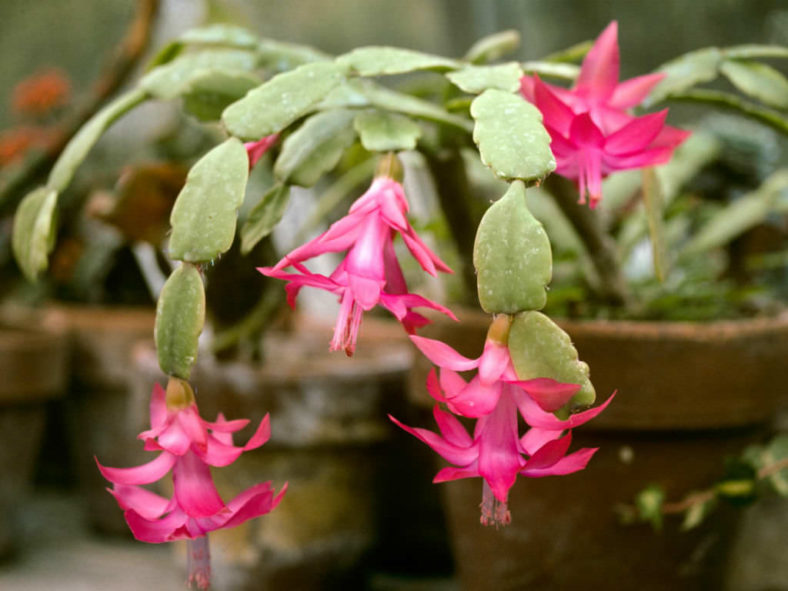The Christmas Cactus is a common houseplant that blooms during the Christmas season, but its long, green stems are attractive throughout the year. It is a plant worthy of appreciation with cultivars in a rainbow of colors. These ten facts about Christmas Cactus will help you care for your plant.
1. It is a cactus but thrives in cooler temperatures. The Christmas cactus should be kept away from heat sources. A Christmas Cactus will blossom longer when exposed to only cooler temperatures. For best results, keep your Christmas Cactus in a cool place (away from heaters and fireplaces) with no frequent drafts (right next to a frequently used door would not be a good place). Significant temperature changes can cause the blooms to drop off the plant before opening. The optimal temperature for a Christmas Cactus is 68°F (20°C).
2. Christmas Cactus needs light to bloom. Keeping your Christmas Cactus in a sunny location indoors is key to prolonging its blooms. However, if you move it outside during the summer, you will have the most success in a partially shaded location, as too much direct light can burn the leaves.
3. The Christmas Cactus is native to Brazil. This epiphyte (a plant that grows on top of another non-parasitically) grows in the Brazilian rainforest among tree branches. As a tropical plant, it thrives in humid conditions.
4. The Christmas Cactus needs its beauty sleep. Set your Christmas Cactus in a room where you never turn the lights on at night. The Christmas Cactus needs 14 hours or more of continuous darkness daily to develop flower buds. However, after the flower buds have set, the Christmas Cactus can withstand nighttime lights.
5. Unlike the other Christmas favorite, the Poinsettia, the Christmas Cactus is not toxic to dogs and cats. Poinsettia is famously poisonous to dogs and cats. However, according to the ASPCA, if Fido or Fluffy nibbles on a Christmas Cactus, she should not experience irritation or vomiting as she would from the sap of the Poinsettia.

6. Christmas Cactus can live for 20 to 30 years. Can you imagine passing a living, flowering plant on to your children or grandchildren? When properly cared for, Christmas Cactus can live for 20 to 30 years. If you provide long nights starting around October 1st, you can force the Christmas Cactus to bloom year after year. Cool night temperatures can also encourage it to bloom.
7. Overwatering will kill the Christmas Cactus, but it likes to be misted daily. Some horticulturalists recommend adding only water to the soil when the Christmas Cactus is planted, provided the soil is dry to the touch. Instead, others suggest misting the leaves of the Christmas Cactus to maintain the desired humidity level around the plant.
8. Five diseases commonly infect Christmas Cactus. Some experts provide a handy fact sheet outlining plant diseases that often affect Christmas Cactus. Their list includes Basal stem rot, botrytis blight, impatiens necrotic spot virus, phytophthora root rot, and pythium root rot.
9. Fungus gnats, flower thrips, and root mealybugs are the pests that most often infest Christmas Cactus. Overwatering appears to be the primary culprit in attracting pests to the Christmas Cactus. Preventative care, such as discarding infested plants, is another recommended tactic. Pesticides are available for commercial growers, although home growers may not use them.
10. By the way, that Christmas Cactus you are buying is probably not a Christmas Cactus. Surprise! The True Christmas Cactus is an interspecific hybrid of Schlumbergera truncata and Schlumbergera russelliana, originating approximately 150 years ago in England. It is a common houseplant but is not often grown commercially. Plants have segments with rounded margins, ribbed ovaries, and purplish-brown anthers. The correct Latin name for Christmas Cactus is Schlumbergera × buckleyi.
Source: wral.com
Links
- Succupedia: Browse succulents by Scientific Name, Common Name, Genus, Family, USDA Hardiness Zone, Origin, or cacti by Genus